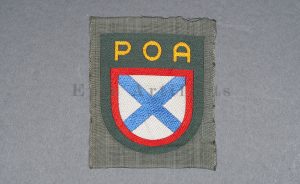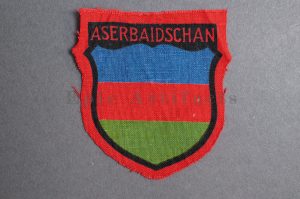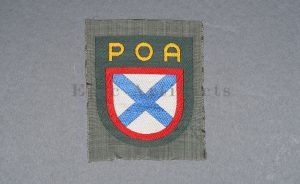Condition: Near Mint
Branch: Heer (Panzer)
Sold
Product Description: These Panzer “Schützen-Regiment 1” Straps are an extremely desirable, early prewar pair of straps to an interesting unit. Each board has a rare “S” cypher (for a Schützen-Regiment, the forerunners of Panzergrenadier units) and a numeral “1” indicating Schützen-Regiment 1, part of the 1. Panzer-Division which fought in the Poland and France campaigns and then on the Eastern Front. These wonderful shoulder straps are a near mint, matching set. They are a sew-in style and have been removed from a tunic. The tops are made of a typical dark green badge cloth fabric, with beautiful pink Panzer piping (correct for this motorized unit type). The rayon piping and dark green felt underlays suggest these boards were tailor made. Each board has early aluminum wire braid rank Tresse as well as one brass alloy pip, indicating the NCO rank of Feldwebel. The original Tresse around the outer edge of the board is the wide style normally used on Waffenrock parade tunics; the Tresse at the lower edge is the standard prewar field tunic style and was added when the original owner was promoted. The cyphers and pips show matching wear with a slight age patina and no doubt are original to the straps. This set of Panzer “Schützen-Regiment 1” Straps would be a great addition to even an advanced German Army insignia collection.
Historical Description: The German military as well as civil, political and paramilitary organizations traditionally used shoulder straps and shoulder boards as uniform insignia, to denote the rank or function of the wearer. After the Nazi rise to power in 1933, there was a tremendous increase in the number of groups and organizations in Germany wearing officially sanctioned uniforms, and most of these organizations used shoulder straps and shoulder boards as a component of their regalia. The exact color of piping utilized, the material color, the type of braid or Tresse that was used, and the number or location of devices and pips present, allow shoulder boards to be tracked to the exact organization that issued them, and often yield even further detail such as the wearer’s rank and even his specific military unit. Normally worn in pairs, the boards were in some cases plain, and in other cases adorned with detailed embroidery or metal emblems. Some shoulder boards were made in the millions, others were specific to a single individual.
We are the leading team of military antique specialists. We have specialized in military antiques for over 25 years.
Epic Artifacts offers free evaluations and the highest prices available for your collectibles.
We purchase single items, entire collections, or family estates.
Click the link here to learn more: Free Evaluation or Inquiries
or feel free to email us directly: info@epicartifacts.com

In stock

In stock

In stock

In stock